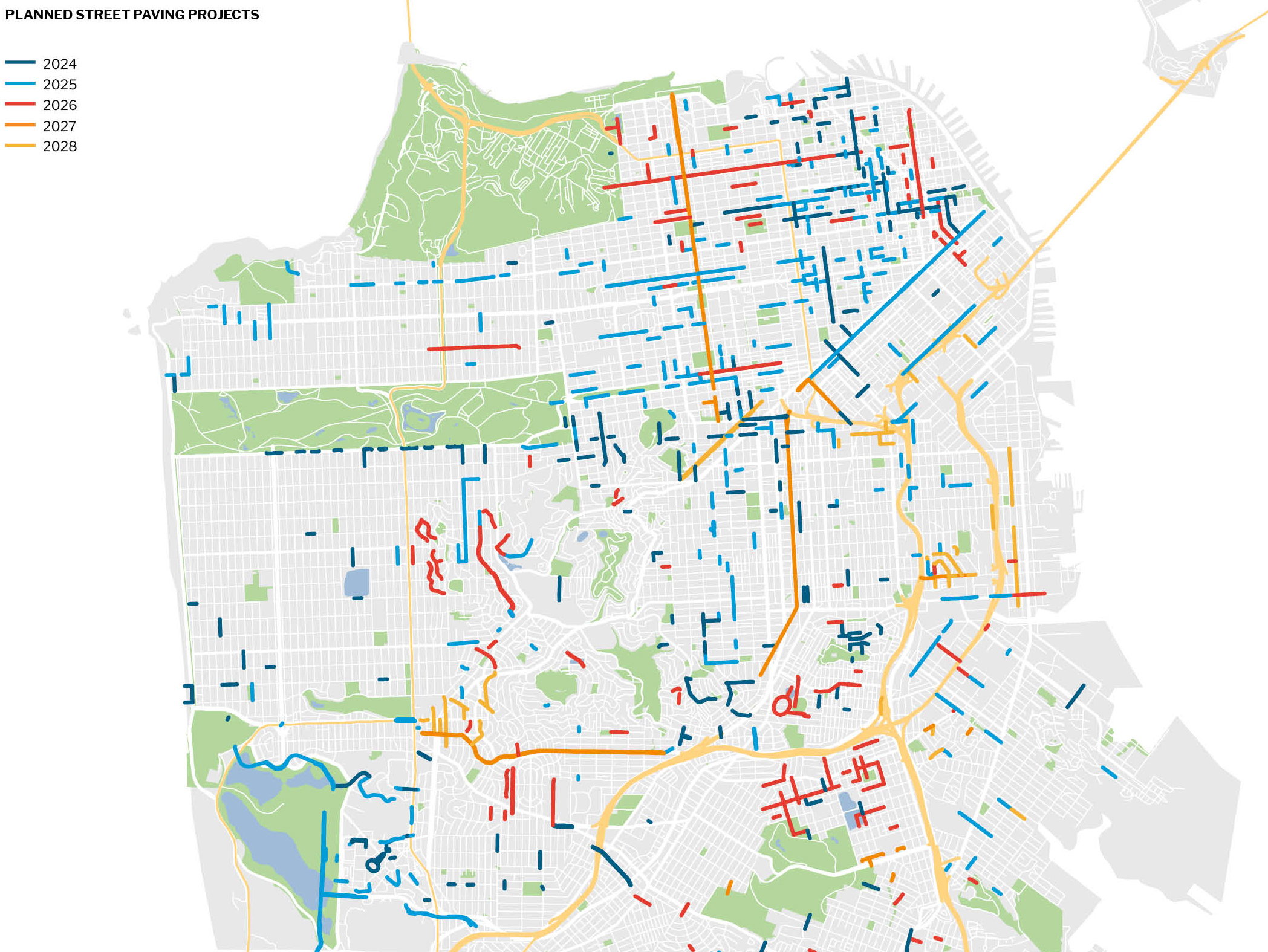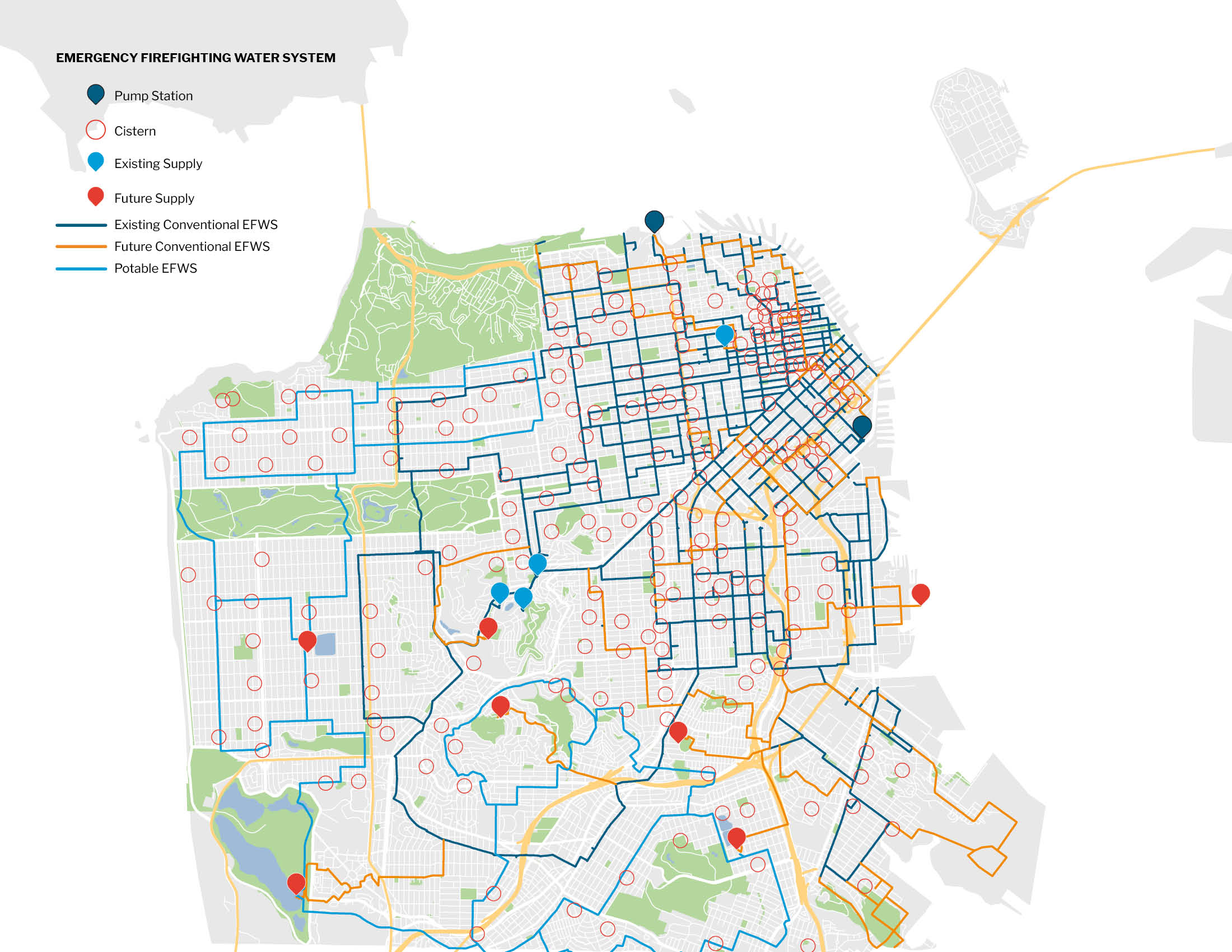SFPUC: San Francisco Public Utilities Commission
The backbone of San Francisco is our horizontal infrastructure; the streets, water, power, and sewer systems that make living in a city possible. Many of these systems function invisibly to residents. They run underground, are walked over, and are turned on with the flick of a switch or the twist of a faucet. The City invests in these systems to provide basic services; and these investments also contribute to City-wide goals of environmental sustainability, pedestrian safety, and a more beautiful and livable city.
It is imperative that the City maintain these assets in a state of good repair given the essential nature of these systems. Proactive maintenance ensures the steady provision of services and is less costly than fixing problems that have degraded beyond repair. High quality service provision is key for advancing equity as utility disruptions or degraded street conditions have disproportionate impacts on low-income people, communities of color, and people with disabilities.
Overview
Programs addressed in this chapter are delivered by San Francisco Public Works (PW) and the San Francisco Public Utilities Commission (SFPUC). Among the key programs implemented by PW are Street Resurfacing, Sidewalk Repair, and Street Tree Maintenance. SFPUC provides San Francisco with water, power, and wastewater systems, implementing multi-billion-dollar programs designed to prolong the life of these assets. Together, these two agencies deliver tangible results that affect the lives of each and every San Franciscan.
Public Works Streets and Rights-of-Way
The City has been able to make significant improvements in its street condition since the 2011 Road Repaving and Street Safety Bond Program. The third and final bond sale was completed in the spring of 2016, rounding out the $248 million program dedicated to street resurfacing, streetscape, and traffic signal upgrade projects. Since then, General Fund, State dollars from SB1, and other sources have contributed to continued street condition improvements. San Francisco voters also approved another $41.5 million for the public right-of-way when they approved the 2020 Health and Recovery G.O. Bond. An additional $60 million of General Fund debt will be issued in FY2023 and FY2024 to offset the shortage of General Fund for this purpose in the short term due to the COVID-19 crisis. The City's Pavement Condition Index (PCI) score is currently at 74.
San Francisco also continues its commitment to Vision Zero SF and its goal of zero traffic fatalities and critical injuries in San Francisco by 2024. San Francisco’s expenditures in streets and right-of-way infrastructure improve safety in myriad ways. Roadway repaving creates a smoother surface and renews street and crosswalk markings, which improve safety for drivers, bicyclists, and pedestrians. Additionally, the City reaffirms our commitment to safe and accessible paths of travel for people with disabilities by making capital improvements to curb ramps, sidewalks, street crossings, and roadways across the city.
Public Utilities Commission
The SFPUC provides and distributes water to 2.6 million customers, treats wastewater, and supplies electric power to operate Muni streetcars and electric buses, street and traffic lights, and municipal buildings. The SFPUC includes three utility enterprises: Water, Wastewater, and Power.
The Water Enterprise consists of over 389 miles of pipeline, over 74 miles of tunnels, 11 reservoirs, five pump stations, three water treatment plants, and nine groundwater wells and treatment facilities located outside of the city (the “Regional Water System”), and over 1,235 miles of pipeline, 11 reservoirs, eight storage tanks, 22 pump stations, seven hydropneumatic stations, and six groundwater wells and treatment facilities located within city limits (the “In-City Distribution System”).
The Water Enterprise is responsible for the distribution of high-quality water to its customer in San Francisco and other Bay Area communities. Hetch Hetchy watershed, located in Yosemite National Park, provides approximately 85% of San Francisco’s total water supply, with the remaining 15% produced by the Alameda and Peninsula watersheds, regional and local groundwater supplies, and recycled water. The drinking water provided is among the purest in the world; the system for delivering that water is almost entirely gravity fed, requiring almost no fossil fuel consumption to move water from the mountains to the tap. Hetchy Water operates, maintains, and improves water and power facilities, smaller dams and reservoirs, water transmission systems, power generation facilities, and power transmission assets.
The Wastewater Enterprise operates and maintains the City's water pollution control plants, pumping stations, and collection system in order to protect public health and the environment. It also maintains the 900-mile long combined sewer system and 27 pump stations that collect sewage and storm water, moving wastewater to treatment plants for eventual discharge into the San Francisco Bay and the Pacific Ocean. The SFPUC is undertaking a Sewer System Improvement Program (SSIP) to modernize its systems and help meet its Levels of Service goals. The SSIP is expected to take place over the next 20 years.
The Power Enterprise is responsible for providing reliable, clean, high-quality electric energy to the city. The Power Enterprise’s 100% GHG-free electric supply portfolio for Hetch Hetchy Power consists of hydroelectric power from three power plants in the Sierra Nevada mountains, solar power generated at SFPUC and other City facilities, and bio-methane power produced at SFPUC wastewater treatment facilities. CleanPowerSF serves more than 380,000 customer accounts and provides San Francisco with an electricity supply from its default “Green” product that is at least 50% CA state eligible renewable and the “SuperGreen” product that is sourced from 100% renewable energy. CleanPowerSF enters into short and long-term power purchase agreements for this energy with project developers and facility owners across the Bay Area and throughout the state.
Power Interconnection Costs
Under the new Wholesale Distribution Tariff (WDT) proposed by Pacific Gas & Electric Company (PG&E) in 2020, all new power interconnections will need to be at primary voltage. This imposes an additional $500,000 for the majority of new interconnections. Any capital project that requires a new, upgraded, or relocated electrical service will be impacted by this requirement. The City continues to litigate the terms and conditions of new WDT (WDT3) at the Federal Energy Regulatory Commission (FERC). These more onerous requirements took effect in April 15, 2021 with the exception of the termination of unmetered load service. The City was able to negotiate an interim agreement to allow some limited service to the City’s existing unmetered loads while the WDT3 is litigated at FERC.
In addition, the WDT rates have transitioned from a fixed rate methodology to formula rates which allows PG&E to impose new costs or adjust rates annually. The result is that the distribution rates have doubled. The City now pays over $20 million per year for distribution level service in addition to approximately $30 million per year for transmission level service through the California Independent System Operator (CAISO). The City must also pay substantial additional costs for the installation of oversized equipment (primary voltage) on secondary loads and costs for upgrades to PG&E’s system. The City has reached a settlement on the new rate structure but is still litigating other costs, including, but not limited to, the requirements for more costly equipment and requirements to pay for upgrades to the PG&E system used for retail customers.



